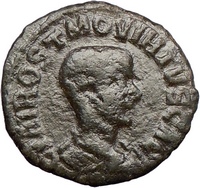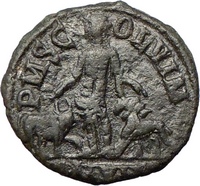Hostilian 251AD Roman Emperor Biography & Ancient Coins Available to Buy
or for a Numismatic
Investment
Buy
Hostilian 251AD Roman Emperor coins from a trusted ancient
coin dealer. Gaius Valens Hostilianus Messius Quintus (230? - 251) was
Roman emperor in 251. Hostilian was
born in
Sirmium (now
Sremska Mitrovica,
Serbia) in
Illyricum sometime after 230, as the
son of the future emperor
Decius by his wife
Herennia Cupressenia Etruscilla. He was
the younger brother of emperor
Herennius Etruscus.
You can find more about Hostilian by watching the vide below
All coins you purchase from the store are professionally researched,
photographed and provided with a lifetime guarantee of authenticity.


Example of Authentic Ancient
Coin of:
Hostilian - Roman Emperor: 251 A.D. -
as Caesar: 250-251 A.D.
Bronze of Viminacium in Moesia Superior
12th year of it's founding 250-251 A.D.
Reference: Varbanov 194
C VAI ROST M QUINTVS CAЄ,
bare-headed, draped & cuirassed bust right
P M S COL VIM, City goddess standing, emblems of legions, bull and lion
at sides, AN XII in exergue.
Viminacium was a major city of the Roman province of Moesia (today's
Serbia), and the capital of Moesia Superior. Viminacium was the base
camp of Legio VII Claudia, and hosted for some time the IIII Flavia
Felix. It was destroyed in 440 by the Huns.
Legio septima Claudia Pia Fidelis (Seventh
Claudian Legion) was a
Roman legion. Its emblem, as well as of
all Caesar's legions, was the bull, together with the lion.[citation
needed]
The 7th, along with the
6th,
8th &
9th were all founded by Pompey in Spain
in 65 BC. They were ordered to
Cisalpine Gaul around 58 BC by
Julius Caesar, and marched with him
throughout the entire Gallic Wars.
Legio VII was one of the two legions used in
Caesar's invasions of Britain, and
played a crucial role in The
Battle of Pharsalus in 48 BC, and it
existed at least until the end of the 4th century, guarding middle
Danube.
Tiberius Claudius Maximus the Roman
soldier who brought the head of
Decebalus to emperor
Trajan was serving in Legio VII
Claudia.
Viminacium was a major city of the
Romanann province of
Moesia (today's
Serbia), and the capital of
Moesia Superior. Viminacium was the
base camp of
Legio VII Claudia,
and hosted for some time the
IIII Flavia Felix.
It was destroyed in 440 by the
Huns, but rebuilt by
Justinian I. During
Maurice’s Balkan campaigns, Viminacium
saw destruction by the
Avars in 584 and a crushing defeat of
Avar forces on the northern Danube bank in 599, destroying Avar
reputation for invincibility.
Today
Kostolac, a small
Serbian town on the
Danube river, is located where
Viminacium used to be.
Gaius Valens Hostilianus Messius Quintus (230? - 251) was
Roman emperor in 251. Hostilian was
born in
Sirmium (now
Sremska Mitrovica,
Serbia) in
Illyricum sometime after 230, as the
son of the future emperor
Decius by his wife
Herennia Cupressenia Etruscilla. He was
the younger brother of emperor
Herennius Etruscus.
Following his father's accession to the throne, Hostilian received
the treatment of an imperial prince, but was always kept in the shade of
his brother Herennius, who enjoyed the privileges of being older and
heir. In the beginning of 251, Decius elevated his son Herennius to
co-emperor and Hostilian succeeded him in the title of princeps
iuventutis (prince of youth). Decius and Herennius then set out on
campaign against king
Cniva of the
Goths, to punish him for raids on the
Danubian frontier. Hostilian remained
in Rome due to his inexperience, and empress Herennia was named regent.
The campaign proved to be a disaster: both Herennius and Decius died
in the
Battle of Abrittus and became the first
two emperors to be killed by a foreign army in battle. The armies in the
Danube acclaimed
Trebonianus Gallus emperor, but Rome
acknowledged Hostilian's rights. Since Trebonianus was a respected
general, there was fear of another civil war of succession, despite the
fact that he chose to respect the will of Rome and adopted Hostilian.
But later in 251, the
Plague of Cyprian broke out in the
Empire and Hostilian died in the epidemic. He was the first emperor in
40 years to die of natural causes, one of only 13. His timely death
opened the way for the rule of
Trebonianus with his natural son
Volusianus.
|